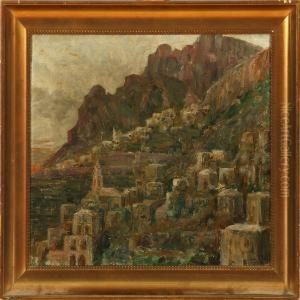Rudolph Christopher Tegner Paintings
Rudolph Christopher Tegner was a Danish sculptor and a controversial figure in the art world of his time. Born on July 31, 1873, in Copenhagen, Denmark, Tegner was known for his unorthodox and modernist approach to sculpture, which often put him at odds with the more conservative artistic community in Denmark during the late 19th and early 20th centuries.
Tegner's artistic journey began at the Royal Danish Academy of Fine Arts where he studied from 1890 to 1897. Despite the traditional training he received, Tegner was influenced by Symbolism and Art Nouveau, movements that were gaining popularity in Europe at the time. His early work already hinted at his inclination towards dramatic expressions and unorthodox themes, which would become more pronounced as his style developed.
He sought inspiration in mythology, particularly Norse legends, and his sculptures frequently explored themes of human emotion, struggle, and existential angst. Tegner's approach was often considered provocative, as he aimed to push the boundaries of the conventional aesthetics of his day. In addition to mythological figures, Tegner also created a number of public monuments and memorials, which were marked by their expressive forms and sometimes stark, monumental scale.
In 1901, Tegner married Elna Jørgensen, who became an integral part of his life and work. She provided not only companionship but also financial support through her inherited wealth, which allowed Tegner the freedom to create his art without the constraints often imposed by the need for commercial success.
Perhaps his most ambitious project was the creation of the Tegner Museum and Statue Park in Dronningmølle, North Zealand, which he established in 1938. Here, Tegner aimed to create a space where his works could be displayed as he intended, surrounded by nature and away from the confines of traditional museum settings. The museum, which still exists today, serves as a testament to Tegner's vision and houses the largest collection of his works, including sculptures and drawings.
Tegner's career was not without its challenges; his art was often the subject of public debate and criticism. Yet, his commitment to his vision never wavered, and he continued to produce work that was both innovative and introspective. Rudolph Tegner passed away on June 5, 1950, leaving behind a legacy that would influence Danish sculpture and continue to provoke thought and discussion among art enthusiasts and scholars alike.
